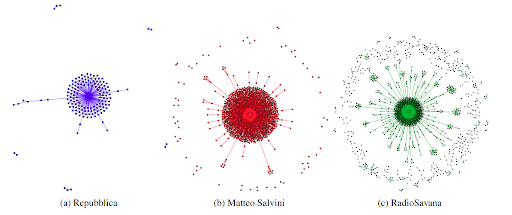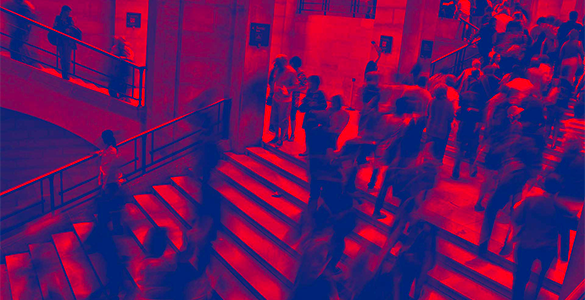The strange case of RadioSavana: how some unreliable sources took over the Italian Twittersphere during the 2020 lockdown
Authored by: Guglielmo Cola (CNR-IIT)
Revised by: Maurizio Tesconi (CNR-IIT)
Over the last decade, social networks have become an essential means of communication and, for some people, even a primary source of information. This was particularly true during Covid-related lockdowns, as real-life social interactions suddenly became impossible. Alongside reliable and authoritative sources, social media are characterized by the widespread presence of malicious accounts, which can expose individuals to a variety of risks, including health-related disinformation. In 2020, Italy was the first Western country to face a lockdown, which turned the Italian Twittersphere into an interesting case study for health-related content production and amplification.
In this blog post, we report some of the most interesting findings from our research article "Italian top actors during the COVID-19 infodemic on Twitter." Between January 30 and March 20, 2020, we used the Twitter Streaming API to collect over 3.6 million tweets in Italian, consisting of original tweets, retweets, and replies that included Covid-related keywords. Then, we found the ten most retweeted accounts, which are listed in Table 1 with some additional statistics:

Table 1: Most retweeted Italian Twitter accounts.
Accounts were classified according to three categories: Civil Society; Media; Politics and Institutions. It turns out that, instead of authoritative sources like institutional accounts, popular health experts, and reputable news outlets, the most retweeted account was an unfamiliar profile supporting anti-government and anti-immigration ideas: RadioSavana. This account, which apparently is not linked to any individual, political party, or movement, somehow managed to achieve over 60,000 retweets, despite having the lowest number of followers (17,403). Indeed, it can be observed that RadioSavana achieved extremely high ratios in terms of retweets per retweeter and in terms of retweeters per follower. Two other accounts in the top-four positions belong to the Civil Society category: Francesco Burioni is a well-known virologist who gained great popularity during the lockdown; Francesca Totolo is a social media manager and contributor of an online magazine linked to the far-right movement Casa Pound. The remaining accounts belong to Media or Politics and Institutions. Most of the Media accounts represent well-known and reputable sources (Agenzia Ansa, Repubblica, Mediaset TgCom24, Sky Tg24), whereas Ultime Notizie is substantially less popular to the general public, as it is only active as a website and on social media. The accounts belonging to Politics and Institutions are Matteo Salvini (leader of the Lega party) and the official account of the Ministry of Health.
To better understand the audiences of these accounts, we studied the adopted hashtags and the overlap between retweeters. The audiences of the Media accounts in the list do not seem to be polarized, as we could verify the use of similar hashtags and a relatively high overlap between retweeters. At the same time, our study highlighted the presence of a connected cluster of retweeters shared by RadioSavana, Francesca Totolo, and Matteo Salvini, which could be explained by the ideological link between their political positions. As such, these results suggest that Covid-related interactions in the Italian Twittersphere, apart from neutral media outlets, were dominated by far-right stances.
To investigate how these accounts managed to achieve such high visibility, we measured the potential reach of their tweets as shown in Figure 1.

Figure 1: Potential reach of the most retweeted accounts. Each dot represents a tweet: color denotes the author, whereas size denotes the potential reach (secondary audience).
This plot shows a dot for each produced tweet: dot color identifies the account that posted the tweet, whereas dot size depicts the potential reach of the tweet. We calculated the potential reach as the total number of followers of the retweeters of a tweet. Thus, the potential reach shows the maximum number of users that might have been reached at the second step of the retweet chain (secondary audience). This is particularly useful to understand if information propagation was favored by the presence of "influencers", i.e., accounts with a high number of followers. Figure 1 reveals that, despite a high number of tweets in the monitored period, Media accounts tend to have a relatively low potential reach (small dots). The account showing the largest secondary audience is Roberto Burioni, which could be expected due to the popularity of the virologist in the Covid-related debate. However, it is again surprising that RadioSavana managed to have a larger secondary audience than most of the other accounts, and that, on some days, it achieved a potential reach comparable to the Ministry of Health.
Another interesting view on the way information is spread through the platform is represented by the so-called retweet cascades, which describe the flow of information from source to retweeters at different levels (followers of the source, followers of followers, etc.). Three examples are provided in Figure 2, which shows the retweet cascades of Repubblica, Matteo Salvini, and RadioSavana.

Figure 2: Examples of retweet cascades.
It is possible to observe three different patterns in the information flow: Repubblica, like the other Media accounts, was mainly retweeted by its followers; Matteo Salvini's account was mainly retweeted by followers as well, but it also managed to reach some tightly knitted clusters beyond the first level (Francesca Totolo's retweet cascade shows a similar pattern); RadioSavana, like Roberto Burioni and the Ministry of Health, was able to reach audiences beyond its follower base, thanks to the presence of multiple nodes that spread the information to their respective communities. Overall, these results confirm the well-known "million follower fallacy," as a high number of followers does not necessarily guarantee the reach of a wider audience.
In conclusion, the Italian Twittersphere debate on Covid-19 was dominated by some unreliable sources that managed to exploit active followers and/or influencers to reach an audience far larger than their follower base. Even if our results do not show evidence of the presence of social bots, it would be important to further investigate whether some of these accounts took specific actions to increase their number of retweets, for example, by buying automated retweets.
The dataset is publicly available at this link.

